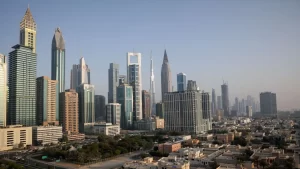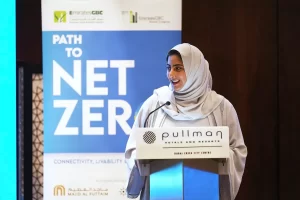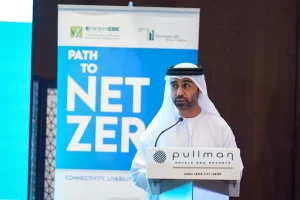
A general view of the Burj Khalifa and the downtown skyline in Dubai, United Arab Emirates. (Reuters)
“Cities in the UAE are thinking of the path to Net Zero as the country is set to host the COP28 by 2023 which will put the Emirates in a leading position in sustainability. This is the beginning,” Dr Ali Al Jassim, Chairman of Emirates Green Building Council (EmiratesGBC) said in an interview with Al Arabiya English.
The comment was made during the 11th Annual Congress of EmiratesGBC in Dubai on Wednesday, during which policy makers, urban planners, architects, came together to discuss the theme of ‘Path to Net Zero 2050: Connectivity, Liveability, and Sustainability.’
The theme of the Annual Congress itself was inspired by the UAE’s Net Zero by 2050 Strategic Initiative.
Dr. Al Jassim, in comments to Al Arabiya English, said that the theme of EmiratesGBC’s Annual Congress has an objective to have cities present initiatives, goals, and visions to the path of Net Zero by 2050 citing the We have examples where cities have presented their visions and plans – Dubai Masterplan 2040 and Ajman’s initiative for 15-minute City,” he said.
“EmiratesGBC has already provided a lead the Middle East and North Africa (MENA) region for the past 15 years on sustainability, climate change, and Net Zero initiatives and we are proud to share our expertise and experience with the other Green Building Councils in the region where we can exchange and share the knowledge and with the other Green Building Councils,” he added.
Inaugurating the Annual Congress and delivering the opening address, Sheikha Shamma bint Sultan bin Khalifa al-Nahyan, Honorary President of EmiratesGBC and CEO of Alliances for Global Sustainability (AGS), said: “The UAE’s Net Zero by 2050 Strategic Initiative is the key national driver for energy transition and decarbonisation. To achieve this, it is important that all stakeholders come together and take concerted action, underpinned by the strategic direction that positive climate action will unlock economic opportunities that benefit all.”

Sheikha Shamma bint Sultan bin Khalifa Al Nahyan, Honorary President of the EmiratesGBC and CEO of the Alliances for Global Sustainability (AGS). (Supplied)
She urged key players in the industry “to explore the ideal path towards decarbonisation by sharing innovative solutions and demonstrating our commitment to tackling climate change ahead of our nation’s presidency of next year’s COP28.”
“The region has a significant opportunity to lead in this this sector,” Sheikha Shamma said and called for “meaningful discourse in tackling the issue of climate change. I urge you all to be part of the solution.”
Dr. Ali al-Jassim, in his speech said: “EmiratesGBC continues to champion sustainability within the building and construction industry. The building industry is a significant contributor to greenhouse gas emissions and it is important to embrace the latest technologies and innovative solutions to support the national goals for decarbonisation and energy transition. Through strong public-private partnerships and industry-academic linkages, we support the UAE’s ambition to set a new model in climate action.”

Dr Ali Al Jassim, Chair of EmiratesGBC. (Supplied)
Habiba al-Marashi, co-founder of the EmiratesGBC, told Al Arabiya English: “Holding the conference under the title of ‘Path to Net Zero 2050’ this year by EGBC was very timely and pertinent as the UAE is preparing itself to host COP28 in 2023. We aim to provide a platform to deliberate, discuss and highlight the economic opportunities offered by the path to net zero which directly support the vision of developing the UAE into the most dynamic and sustainable economy in the world.”
Among others, the Congress discussed the topics of adapting to climate change and the need to rethink connectivity in cities. Experts and stakeholders from the building and construction industry also explored how Net Zero can be achieved within the green building industry.
The topics of digital transformation and its role in achieving Net Zero and innovations in energy efficiency in buildings was also explored.
Dubai 2040 Urban Master Plan
The Dubai 2040 Urban Master Plan maps out a comprehensive future map for sustainable urban development in the city.
Hanan al-Hashmi, Urban Planner, Dubai Municipality, illustrated the growth of city over the decades from a fishing village and natural harbor in 1950 to a future where we are looking at an increase of its population from 3.3 million in 2020 to 5.8 million in 2040.
“The plan seeks to enhance quality of life by increasing population density around key mass transit stations and maximizing the utilization of available spaces within limits of current city,” said al-Hashmi.
Sustainable growth will be achieved by doubling the green and recreational areas across the emirate. Nature reserves and rural natural areas will compose 60 percent of emirate’s total area. Land area for hotels and tourist activities will increase by 134 percent. Land for commercial activities will increase to 168 sq. kilometers.
Area allocation for Education and health facilities will increase by 25 percent and the length of public beaches will increase by 400 percent.
Mass transit use, walking and cycling as means of mobility will be encouraged and facilitated.
As per the plan, she said, discussions around liveability will focus on creating inclusive and sustainable spaces as well as people’s health and well-being, happiness and quality of life.
Designed to realise the vision of Sheikh Mohammed bin Rashid Al Maktoum, Vice President and Prime Minister of the UAE and Ruler of Dubai, to make Dubai the city with the world’s best quality of life, the plan aims to provide the highest standards of urban infrastructure and facilities.
Al-Hashmi termed the Dubai 2040 Urban Master Plan as a “future-shaping tool, and a comprehensive document” which drawn up after extensive consultations with the public and stakeholders.
The plan categorizes Dubai’s urban area into five main urban centers/zones; Deira and Bur Dubai, Downtown and Business Bay, Dubai Marina and JBR as well as two new centers – Expo 2020 Center and Dubai Silicon Oasis Center, each with their own unique attributes and activities to aid economic growth and provide lifestyle facilities suited to cater the needs of the population.
The plan then aims to enhance the quality of life by increasing: efficiency of resource utilization, economic activity and foreign investment in all five zones while preserving the emirate’s heritage and its environment.
All urban centers will be equipped with facilities such as infrastructure, transit & energy as well as services such as hospitals, schools, leisure centers and government services which will be equally accessible to all their residents.
The people-centric Plan focuses on reinforcing Dubai’s competitiveness as a global destination by providing a wide diversity of lifestyle and investment opportunities for citizens, residents, and visitors over the next 20 years.
“Included among the strategic goals is the safeguarding the emirate’s cultural and urban heritage,” said al-Hashmi.
This guides Dubai’s evolution into a city that promotes the greatest human values and possibilities and an environment where people from around the world can thrive.
Ajman: Region’s first 15-minute city
A case study on Ajman, which aims to become the region’s first 15-minute city by providing residents with easy access to services via walking, cycling and public transport routes by 2030, was presented by Dr. Hooriah Ahmed, Infrastructure Development Sector Planning Advisor at Ajman Municipality & Planning Department, presented, presented the study.
Ajman joins cities such as Paris, Dublin, Melbourne Cities and countries such as Singapore that have launched strategies and plans to implement the concept of 15-minute cities.
Ajman’s Department of Municipality and Planning adopted the application of the theory of 15-minute cities within its strategy in November 2021.
Dr. Ahmed said the concept is based on the four pillars – proximity, diversity, density and being ubiquitous – so that all the uses and facilities a person needs can be found within 15 minutes of walking from where they live or by public transport, bicycle and electric. “And each neighborhood should fulfil six essential social urban functions: living, working, supplying, caring, learning, and enjoying,” she added.
“Making the 15-minute city real mean investing in municipal services and attracting new businesses, and this requires a gradual redevelopment in existing plans for new construction and redevelopment in city districts. In fact, to us the point is not to have every cultural amenity and human desire within immediate reach of one’s doorstep only, it is more about providing services in a proactive and smooth manner and improving the quality of life in terms of wellness, liveability and community relations and to change the culture in the behavior of the community,” she said.
Since the launch of the initiative, an electronic system has been developed to measure the distances between the five main functions, analyzing the current situation and re-prioritizing project implementation, she added.
The maps show the various neighborhoods and what services are available there. The population density in each sector has also been taken into consideration.
A system of video displays helps to determine the main activities when clicking on any point on the map. From this point, the system calculates the time consumed to reach the services using three means: walking, electric bicycles, private cars, and the other details of the sites like the shop name.
The system also analyzes the sites where the functions are concentrated in the emirate, contributing to the priority implementation of projects and initiatives.
It is being used internally at present by the Municipality, revealed Dr. Ahmed. The next step this year will be to make it available to partners such as the Department of Economic Development to organize the process of distributing activities according to the needs of the sectors.
During the following year, it will possibly be available to the public, she said.
“We started to implement the concept of 15-minute city and are happy with the progress and the response of the leadership and the government and the private sectors participants We hope that our efforts in this direction will inspire others too to apply the concept innovatively.”






























